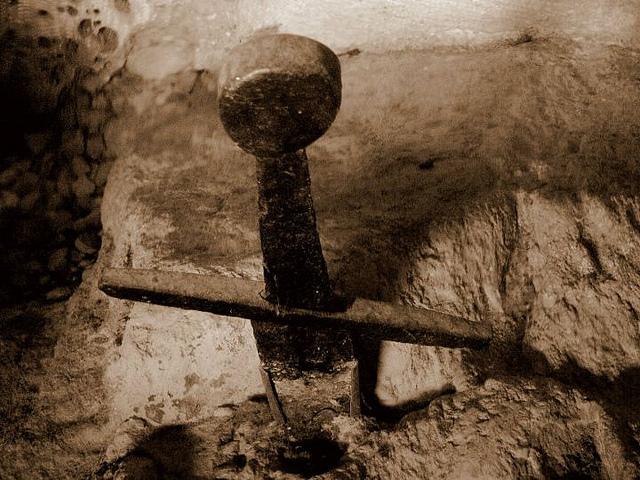The sword in the stone
ITA:

Use player to listen to Italian version
The sword in the stone
The “sword in the stone” myth that we all know from King Arthur has echoes in the story of an obscure Italian saint, San Galgano, but unlike the sword from the Arthurian legend that has been lost in the mists of time, its Italian counterpart can still be seen – near Siena in Tuscany. Enclosed in the round chapel of Montesiepi the sword, which is plunged up to its hilt in a smooth stone, has been dated to the 12th Century by scientific tests. Legend and Vatican documents report that the sword belonged to the knight Galgano Guidotti, who later became Saint Galgano. He was born Galgano Guidotti in 1148. Official accounts of his life say he was a hotheaded and arrogant lad. He grew up to be an unruly knight, who indulged in violent and carnal pleasures with abandon until the Archangel Michael appeared to help the wayward knight to salvation.
Legend has it that on a long journey Galgano fell badly when his horse reared. A celestial voice led the knight to Monte Siepi, a small hill in the rugged forests of Siena where he saw a round temple with Jesus and Mary surrounded by the Apostles. When he reached the top of the hill the voice invited him to renounce worldly pleasures. Sir Galgano objected, reasoning that although giving up worldly pleasures sounded like a good idea, it would be easier to split rocks with his sword. To prove his point he drew his weapon and struck a stone expecting the blade to snap. Instead the sword penetrated the stone up to its hilt. Galgano became a hermit and never left the hill again, living in poverty in a cave.
The wages of sin...
Galgano befriended the wild animals of the forest and local farmers came to ask his blessing. He was saved from an envoy of the Devil who, disguised as a monk, tried to remove the sword from the stone. Galgano’s loyal wolves tore the man to pieces, leaving only his arms as a warning to others who thought of removing the sword. One year later Galgano died. The following year the Bishop of Volterra gifted Monte Siepi to the Cistercians monks, so that they could build a shrine to Galgano’s memory. The monks began construction of the beautiful round temple in 1185, the year in which Galgano was canonized.
Legend holds that after Galgano’s death his scalp continued to grow luxuriant blond curls and his miraculous head was placed in one side chapel, and the chewed arms of the evil man in another. Pilgrims to the chapel were so numerous that the Cistercians were authorized to build another monastery named after the Saint a short distance fromMonte Siepi. A huge gothic abbey was erected in the name of Saint Galgano, not unlike the Abbey in Wells, Somerset, and many of the Abbey’s monks attained high office throughout Tuscany.
As the power of the Abbey diminished, absentee Abbots plundered the Abbey right down to the lead roof which was sold in 1548.
The round chapel survives on its sunny knoll overlooking the still elegant columns and arches of the abbey ruins. The sword in the stone is intact, deep in southern Tuscany while the myth of King Arthur has been carried into the 21st Century.
The mistery deepens
Some medievalists maintain that San Galgano’s story is the source of the King Arthur ‘sword in the stone’ legend. Though the first written accounts of the legend of Arthur goes back to the 9th Century (Historia Brittonum), there is no mention of a sword in a stone until the 13th century, by which time Galgano’s sword was well-know throughout Europe. The sword was first mentioned by French poet Robert de Boron, though in his work it was embedded in an anvil on top of a stone. Later, in 1240, Thomas Malory introduced the distinction between the sword Excalibur given by the Lady of the Lake and Arthur’s sword in the rock.
Perhaps we’ll never know the link between these two men of history. The key may lie in the journeys of crusading knights passing from France to Rome along the ancient Via Cassia, on which the Abbey of Galgano would certainly have been a stop. What is not so clear is whether the legend of the sword in the rock passed from theFrench knights to the Italian monks, or vice versa.
The main difference between the stories of King Arthur and Saint Galgano is that whereas Galgano thrust his sword into the stone to renounce a life of violence, Arthur withdrew the sword from the rock to prove that he was the rightful King of England to lead his army.
But who put the sword in the rock?
La spada nella roccia
Il mito della Spada nella Roccia che tutti conosciamo da Re Artù, riecheggia la storia di un oscuro santo Italiano, San Galgano. Ma mentre la spada della leggenda di re Artù è andata persa nella notte dei tempi, l’equivalente spada Italiana è ancora visibile in Toscana. Racchiusa nella Rotonda di Montesiepi non molto lontano da Siena, e conficcata in una liscia roccia fino alla sua impugnatura, la spada è stata scientificamente datata al XII secolo.
Leggenda e documenti del Vaticano riportano che la spada apparteneva al nobile cavalier Galgano Guidotti, che dopo è diventato San Galgano. Nacque come Galgano Guidotti nel 1148. Racconti ufficiali della sua vita lo danno come giovane arrogante e testacalda.
Crescendo divenne un cavaliere impetuoso intento ad assecondare i suoi piaceri violenti e carnali con completo trasporto,finchè non gli apparve l’arcangelo Michele per indirizzarlo sulla via della salvezza.
La leggenda narra che durante un lungo viaggio, Galgano cadde malamente quando il suo cavallo s’imbizzarrì. Una voce celestiale guidò il cavaliere sopra il Monte Siepi, una piccola collina nelle boscaglie inospitali intorno Siena, dove vide Gesù e la Madonna circondati dagli apostoli, in un tempio a forma sferica. Appena giunse in cima al monte, la voce gli chiese di rinunciare ai piaceri terreni. Cavalier Galgano ribatté che sebbene il rinunciare ai piaceri terreni fosse una buona idea, sarebbe stato però più facile recidere roccie con la spada. E per provare quanto aveva appena detto, sguainò la sua arma e infilzò una roccia convinto che la lama si spezzasse. Invece la spada penetrò nella roccia fino all’impugnatura.
Galgano divenne un eremita e non lasciò mai più il monte, vivendo in povertà all’interno in una caverna.
Il salario del peccato
Galgano faceva amicizia con gli animali selvatici della foresta, e i contadini del luogo gli chiedevano la sua benedizione. Un giorno fu salvato da un emissario del diavolo, che travestito da frate cercò di tirar fuori la spada dalla roccia. I fedeli lupi di Galgano si avventarono sull’uomo facendolo a pezzi e ne lasciarono soltanto le braccia come messaggio per chiunque avesse ritentato di estrarre la spada. Un anno dopo Galgano morì. L’anno seguente il Vescono di Volterra regalò Montesiepi ai monaci Circensi per costruirci un santuario in memoria di Galgano. I monaci iniziarono la costruzione del bel tempio rotondo nel 1185, lo stesso anno in cui Galgano fu canonizzato santo.
La leggenda narra che miracolosamente dopo la morte del Santo, la sua capigliatura riccia e bionda continuò a crescere, e la sua testa miracolata fu custodita in una cappella laterale della Rotonda e in un’altra i monaci vi custodirono le braccia sbranate dai lupi. Ma i pellegrini che visitavano la cappella erano così numerosi, che i monaci Circensi furono autorizzati a costruire un altro monastero nei pressi di Montesiepi e con lo stesso nome del santo. Una gradissima abbazia gotica fù così innalzata nel nome di San Galgano, non molto dissimile dall’Abbazia di Wells nel Somerset, e molti dei monaci dell’abbazia di San Galgano furono investiti di alte cariche clericali nell’intera Toscana.
Col diminuire del potere dell’abbazia, nel 1548 i pochi Abati rimasti furono costretti a depredare l’abbazia fino a vendere il piombo del tetto. La Rotonda invece è sopravvisuta sul promontorio assolato che domina le ancora eleganti arcate e colonne delle rovine dell’abbazia. La spada nella roccia è ancora lì intatta all’interno della Toscana meridionale, mentre il mito di re Artù è stato tramandato nel XXI secolo.
Il mistero diviene più profondo
Alcuni studiosi del medioevo sostengono che la storia di San Galgano sia la fonte della leggenda della spada nella roccia di re Artù. Infatti, sebbene i primi racconti scritti della leggenda di re Artù risalgono al IX secolo (Historia Brittonum), non ce menzione della spada nella roccia fino al XIII secolo, quando la spada di Galgano era già famosa in tutta Europa. La spada fu menzionata per la prima volta dal poeta francese Robert de Baron, sebbene nella sua opera la spada era infilzata in un incudine sopra una roccia. Dopo, nel 1240 Thomas Malory introdusse la distinzione fra la spada Excalibur donata dalla Signora del Lago, e la spada nella roccia di Artù.
Forse non scopriremo mai il legame fra questi due personaggi della storia. Un indizio potrebbe sussistere nei viaggi dei cavalieri crociati che si spostavano dalla Francia a Roma per l’antica via Cassia, lungo la quale l’Abbazia di San Galgano sarebbe stata sicuramente un punto di sosta. Comunque ciò che non è ancora chiaro è se la leggenda della spada nella roccia sia stata tramandata dai cavallieri francesi ai monaci italiani o viceversa.
La differenza sostanziale fra la storia di Re Artù e San Galgano è che mentre Galgano ha conficcato la spada nella roccia in segno di rinuncia ad una vita di violenza, Artù sguainò la spada dalla roccia per provare che lui era il prescelto Re d’Inghilterra a comandare il suo esercito.
Ma allora chi ha messo la spada nella roccia?











